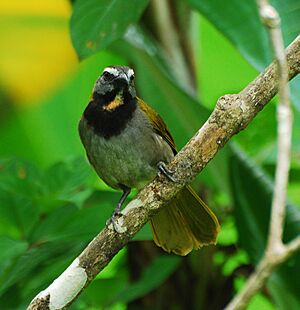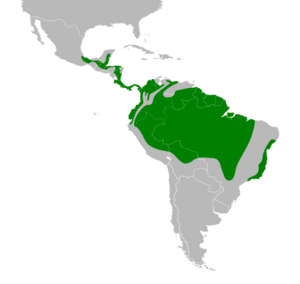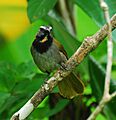Buff-throated saltator facts for kids
Quick facts for kids Buff-throated saltator |
|
|---|---|
 |
|
| Conservation status | |
| Scientific classification | |
| Genus: |
Saltator
|
| Species: |
maximus
|
 |
|
The buff-throated saltator (scientific name: Saltator maximus) is a cool bird that eats seeds. It belongs to the tanager family, called Thraupidae. You can find these birds living from southeastern Mexico all the way down to western Ecuador and northeastern Brazil.
Contents
What Does It Look Like?
The buff-throated saltator is about 20 cm (7.9 in) long. That's about the length of a regular pencil! It usually weighs between 42–52 g (1.5–1.8 oz).
Adult Birds
Adult saltators have a head that is a dark grey color. They have a white stripe above their eyes, like an eyebrow, and a greenish top of the head. Their back feathers are olive green. Their belly is grey, turning a light brown or "buff" color lower down. The throat is also buff-colored with a black edge. They have a thick, curved black beak and black legs.
Young Birds
Young buff-throated saltators look a bit different. They are not as brightly colored. Their throat and chest are blackish with white spots. They also have brown marks on their lower belly.
Sounds and Songs
These birds are quite vocal! Their common call is a high-pitched sound that sounds like seeeer.
Duet Singing
Male buff-throated saltators love to sing together. They perform a beautiful duet! One male might sing a warbled cheery cheery. Another male will then answer with cheery to you. It's like they're having a conversation through song!
Where Do They Live and What Do They Eat?
The buff-throated saltator prefers to live in places with lots of thick plants and trees. They like dense forests and bushes.
What's on the Menu?
These birds have a varied diet. They enjoy eating different kinds of fruit. They also munch on buds from plants and sip nectar, which is a sweet liquid from flowers. Sometimes, they will also eat slow-moving insects. They usually look for food at low and middle levels in the trees. You might even see them joining other bird species in mixed feeding groups!
Nests and Eggs
Buff-throated saltators build their nests in trees or bushes. They make a large, cup-shaped nest. These nests are usually built up to 2 m (6.6 ft) high off the ground.
About the Eggs
Female saltators usually lay two pale blue eggs at a time. Each egg is about 22–32 mm (0.87–1.26 in) long and 16.5–21.5 mm (0.65–0.85 in) wide. They weigh around 4.8–6.1 g (0.17–0.22 oz) each. These eggs are quite large compared to eggs from other Saltator birds.
Images for kids




